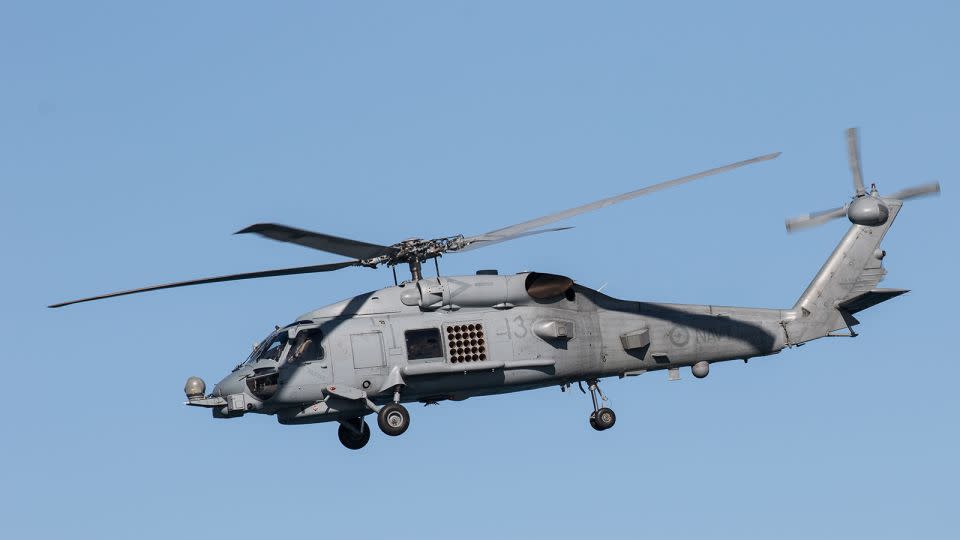Chinese warplane fired flares, put Australian Navy helicopter in danger, Canberra says

Australia has accused a Chinese fighter jet of firing flares into the path of a naval helicopter last weekend over international waters of the Yellow Sea, an action that Prime Minister Anthony Albanese blasted as “completely unacceptable.”
The Australian MH-60R Seahawk helicopter was on patrol enforcing United Nations sanctions on North Korea at the time of the incident, the Defense Ministry in Canberra said, adding the move put the lives of the helicopter crew in danger.
“This was an unsafe maneuver which posed a risk to the aircraft and personnel,” the statement from Australian Defense Minister Richard Marles said.
The Chinese jet “dropped flares about 300 meters (984 feet) in front of the Seahawk helicopter and about 60 meters (197 feet) above it,” Marles said in an interview with CNN affiliate Nine News on Monday.
No damage or injuries were reported, but flares can lead to the downing of a helicopter if they strike and damage its rotor blades, or if they are ingested into its engines.
The incident is the latest in a growing list of confrontations in international waters between China’s military and other nations, and it comes as Canberra and Beijing are pursuing a rapprochement following a bruising few years of trade disputes and strained relations.
China defended the action by its military and rejected Australia’s claim that the interception was unsafe.
“Under the guise of implementing United Nations Security Council resolutions, Australian warships and aircraft deliberately approached China’s airspace to cause trouble and provocation, endangering China’s maritime and air security,” Foreign Ministry spokesperson Lin Jian told reporters at a regular briefing.
“As a warning, the Chinese military took necessary measures at the scene. Relevant operations are legal, compliant, professional and safe.”
In a separate statement, China’s Ministry of Defense said the Australian helicopters were conducting “close reconnaissance” during China’s “normal training activities” and called its actions warning them to leave “legitimate.” It also accused Australia of “spreading false narratives.”
The MH-60 Seahawk is a twin-engine helicopter and carries a crew of three, according to the Australian Navy.
The Australian helicopter was operating from the destroyer HMAS Hobart in international waters of the Yellow Sea as part of Operation Argos, Canberra’s contribution to a multinational effort to enforce UN sanctions against North Korea, according to a statement from the Australian Defense Ministry.
Albanese called the Chinese actions “completely unacceptable” in a television interview Tuesday.
“They’re in international waters, international airspace, and they’re doing work to ensure that the sanctions that the world has imposed through the United Nations on North Korea, due to their intransient and reckless behavior, are enforced,” the prime minister told CNN affiliate Nine News.
“They shouldn’t have been at any risk while they engaged in that behavior,” Albanese said of the Australian crew.
Albanese said “appropriate diplomatic representations” have been made with Beijing.
“We’ve just made it very clear to China that this is unprofessional and that it’s unacceptable,” he said.
The incident was similar to an encounter between a Chinese fighter jet and a Canadian military helicopter over the South China Sea in late October when flares were also fired in the path of the helicopter.
“The risk to a helicopter in that instance is the flares moving into the rotor blades or the engines so this was categorized as both unsafe and non-standard, unprofessional,” Maj. Rob Millen, air officer aboard the Royal Canadian Navy frigate HMCS Ottawa, told CNN after the October incident.
After that incident China defended its actions and accused Canadian forces of conducting unspecified “malicious and provocative act with ulterior motives.”
Australian opposition leader Peter Dutton urged Albanese to call Chinese leader Xi Jinping to express Canberra’s concerns over the latest incident, but also over a long list of Chinese encounters with Australian and allied aircraft and ships.
“At some stage, there’s going to be a miscalculation and an Australian Defense Force member is going to lose their life. That is a tragic circumstance that has to be avoided at all costs,” Dutton said in an interview with Nine News.
“There will be a miscalculation by somebody who’s flying that jet or somebody who’s on the deck of a Chinese naval ship. Something will happen and that’s what, not just Australia is worried about, the Philippines, Japan, obviously the United States, many other countries in the region, who are very worried about these acts that continue to be provocative, and completely and utterly unnecessary.”
Previous contentious and potentially dangerous incidents between Australia and China include an encounter in waters near Japan last November when Australia said a Chinese warship used sonar waves to harass Australian Navy divers in the water trying to untangle fishing nets from the propellers of the frigate HMAS Toowoomba, resulting in minor injuries to the divers.
According to Australian public broadcaster ABC, Australian Navy Vice Adm. Mark Hammond raised the Toowoomba incident in a meeting with Chinese navy Adm. Hu Zhongming at an international naval symposium in Qingdao.
“I sought his concurrence to prioritize the safety of our respective navy personnel and to prevent a reoccurrence of this incident,” ABC quoted Hammond as saying.
In June 2022, a Chinese fighter jet released flares and chaff that entered at least one of the two engines on an Australian P-8A flying in international waters over the South China Sea, Australia said.
Earlier in 2022, Australia said a Chinese warship used a laser to “illuminate” an Australian P-8A aircraft in waters north of Australia.
Pilots targeted by laser attacks have reported disorienting flashes, pain, spasms and spots in their vision and even temporary blindness.
China has denied wrongdoing in all incidents, saying its forces act in accordance with international law while protecting Chinese interests.
This story has been updated with additional developments.
CNN’s Hassan Tayir contributed to this report.
For more CNN news and newsletters create an account at CNN.com


